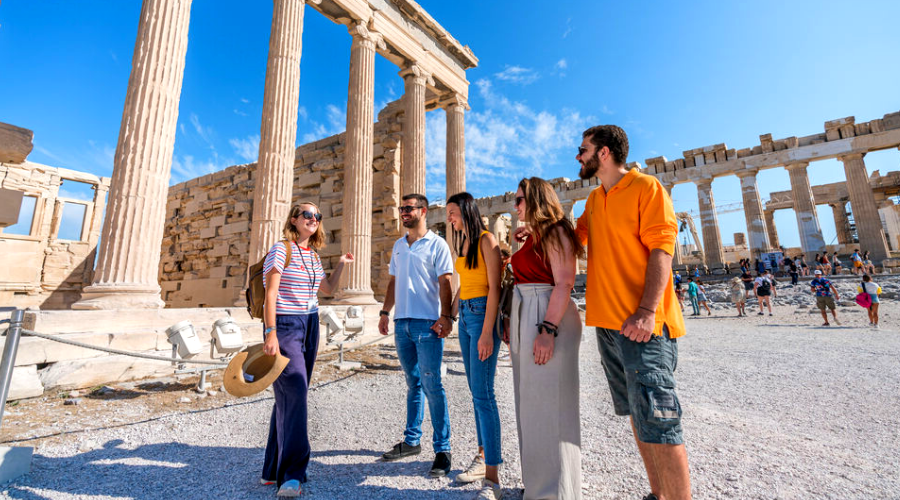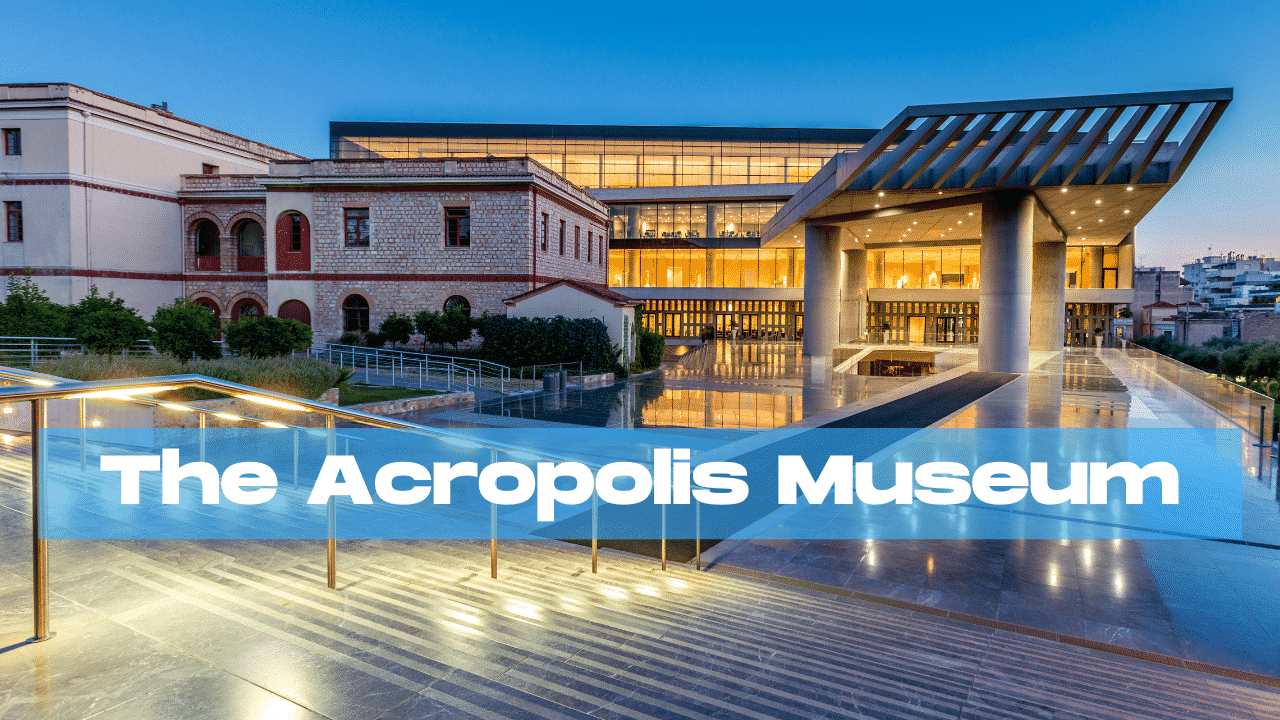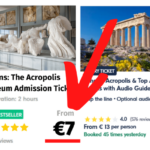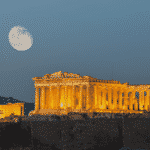The Acropolis Museum: The Home of the Gods
Do you want to visit the
If you’re visiting Athens and want to spend time at the
Quick Links to tickets for the Acropolis Museum for the 2024:
► Skip-the-line tickets can be purchased online via:
- GetYourGuide.com Click HERE From €12 per person (includes free cancellation)
- Tiqets.com Click HERE From €13.00 per person (includes free cancellation)
- Viator Click Here From €14.00 per person (includes free cancellation)
- Headout.com Click Here – Combo:
Acropolis Parthenon +Acropolis Museum Tickets
The
The museum was constructed to hold all of the artifacts discovered on the cliff and adjacent slopes, dating from the Greek Bronze Age through Roman and Byzantine Greece. It also sits on the remains of a Roman and early Byzantine section of Athens.
Buy your Single admission Tickets for the Acropolis Museum CLICK HERE <- GetYourGuide.com
Buy your Combined Ticket including other ancient sites in Athens CLICK HERE <- GetYourGuide.com
The museum was formed in 2003, and the Museum Organization was founded in 2008.
It was first available to the public on June 20, 2009.
Over 14,000 square meters, over 4,000 artefacts are on display.
Professor Emeritus of Archaeology Dimitrios Pandermalis of Aristotle University of Thessaloniki chairs the Organization for the Construction of the New Museum.
 Acropolis and 6 Archaeological Sites Combo Ticket
Acropolis and 6 Archaeological Sites Combo Ticket
- Skip-the-line
- Free cancellation.
The Acropolis Museum Takes Your Hands on History
The first museum was built on the
However, subsequent excavations on the
Another reason for the new museum’s construction was that in the past when Greece requested the return of the Parthenon Marbles from the United Kingdom, which had acquired the items in a contentious manner, some British officials suggested that Greece did not have a suitable location where they could be displayed.
All subsequent ideas for the building of a new museum have included the creation of a gallery for the exhibition of the Parthenon Marbles.
Competitions for the new Acropolis Museum
During the building of the museum, earthworks were carried out at an ancient site at Makrygianni.
The first architectural competition for a new museum was organized in 1976, and it was only open to Greek citizens.
Both the 1976 competition and the one that followed it in 1979 failed to generate any results, owing to the unsuitability of the plots of land chosen for the proposed structures.
In 1989, a third worldwide competition for the design of the new
Manfredi Nicoletti and Lucio Passarelli, two Italian architects, won this competition. Following delays during the 1990s, work on the museum’s construction based on this third design got to the point of foundation excavations, but they were halted due to allegedly sensitive archaeological remains on the site, resulting in the competition’s annulment in 1999.
In hindsight, the new museum’s choice was simple: a big lot of the disused “Camp Makrygianni” gendarmerie barracks, just across from the Theater of Dionysus.
The barracks were constructed on public property, and a limited number of expropriations of nearby private homes were required to make room for them.
The neoclassical “Weiler Structure,” the main building of the former barracks, has been refurbished and now houses the Museum of the Center for
The fourth competition had made no provision for the old site’s preservation.
Only when local and international (ICOMOS) activists uncovered this lapse and it became the final competition were these addressed to some extent.
The revised designs called for the structure to be lifted above ground and supported by pillars.
The competition was only accessible to architectural firms that were invited, and it was won by Bernard Tschumi of New York, in conjunction with Greek architect Michael Photiadis.
The excavation uncovered two layers of tiny, private wayside dwellings and workshops, one from the early Byzantine period and the other from the classical period.
Suitable places for the foundation pillars were determined when the arrangement and stratigraphy of the finds were established.
These float on roller bearings that can endure a Richter scale magnitude 10 earthquake and cross the soil to the underlying bedrock.
The project to relocate the ancient objects the 280-meter (310-yard) distance from the
Officials from Greece expressed their optimism that the new museum would aid in the effort to reclaim the Parthenon Marbles.
Location of the Acropolis Museum, Athens Greece
Acropolis Museum and Parthenon (right).
There’s a museum on the
The museum is the biggest modern structure built thus near to the Parthenon,[citation required] while several other buildings built in the previous 150 years are closer to the
The building’s entrance is on Dionysiou Areopagitou Street, next to the Akropoli metro station on the Athens Metro’s red line.
The Acropolis Museum –The Building
Bernard Tschumi’s design was chosen as the winning proposal in the fourth competition.
The design of Tschumi is based on three ideas: light, movement, and a tectonic and programmatic aspect.
These traits work together to “transform the site’s limits into an architectural opportunity, producing a basic and exact museum” with the mathematical and conceptual clarity of ancient Greek structures.
The museum’s holdings are shown on three floors, with ancillary rooms such as the museum store, café, and offices located on the fourth centre level. The finds from the
The sloping floor of the long and rectangular hall evokes the ascent to the cliff. The visitor is next directed to the enormous trapezoidal hall, which houses the ancient artefacts.
Artifacts and sculptures from other
Visitors will be guided to the top level, which houses the Parthenon marbles, to observe the latter during their descent to maintain the chronological sequence: they will first be sent to the top level, which houses the Parthenon marbles.
To obtain the same cardinal orientation as the ancient temple on the
The Parthenon Hall’s column spacing is identical to that of the ancient temple, and the use of glass on all four outside walls enables natural light to illuminate the Parthenon marble in the same way as it does on the original temple.
The Parthenon Hall’s 48 columns create a colonnade for the exhibition of the Parthenon marble and indicate the shape of the old temple.
The pediment marbles are displayed at eye level in front of the end columns for ease of viewing; the metopes are displayed on the columns, two per column, but not as high as in the ancient temple; and the frieze is displayed behind the metopes, forming a continuous band around the walls of a rectangular space set inside the columns, as in the ancient temple but not as high as in the ancient temple, again for ease of viewing.
The ancient temple on the
Because the museum is situated on top of a large archaeological site, the floor, both outside and within, is commonly made of glass, allowing visitors to view the excavations below. An amphitheatre, a virtual theatre, and a hall for temporary exhibits are also available at the museum.
The light
Because the museum mostly shows sculptures, which need different lighting conditions than other kinds of museums, the museum depends significantly on natural light.
The movement
The visitor’s path is a three-dimensional circle that takes them from the archaeological dig to the Parthenon Hall and back, providing an architectural and spatial experience.
The architecture
The museum’s construction is centred on a concrete core that matches the Parthenon frieze’s precise measurements. The support rooms are located within the core, while the museum’s display spaces are constructed around it and in the atrium that is formed.
The Acropolis Museum Controversy
Archaeological dig underneath the museum’s main entrance.
The proposals for the new museum sparked a debate over whether it was permissible to develop it on an ancient site in the Makrygianni district. Another question was whether a massive contemporary structure would blend in with the surrounding environment.
Another debate occurred in 2007 about the planned destruction of two historic structures.
Numbers 17 and 19 Dionysiou Areopagitou Street, facing the
Bernard Tschumi has been exhibiting photographs of the area in front of the museum that has been manipulated to remove the two buildings and four-story-tall trees. Even though one is Neo-Classical[7]and the other is an example of Art Deco architecture, the Greek government had the two buildings delisted from the historical register.
The Acropolis Museum – Awards
- It received the International Association of Lighting Designers (IALD) Award of Excellence and Sustainability on May 13, 2010. [8]
- The Museum was named the Best Worldwide Tourism Project for 2010 by the British Guild of Travel Writers (BGTW) on November 8, 2010.
- The American Institute of Architects (AIA) Institute Honor Award for Architecture was given to the Museum in 2011.
- It was one of six nominees for the Mies van der Rohe Award, given by the European Union for Contemporary Architecture in 2011.
- The International Institute for Conservation (IIC) in Vienna presented the
Acropolis Museum with the Keck Award 2012 on Friday, September 14, 2012, for its pioneering program of conservation and restoration of the Caryatids. - In 2017, the
Acropolis Museum was voted 8th in TripAdvisor’s Travellers Choice Awards for the World’s 25 Best Museums.
The Acropolis Museum – Other information
A view of the
The museum’s entry cost was €1 for the first year and €5 after that.
The excavation under the ground level is still going on. The ground-level glass flooring allows visitors to see the site and the process. Once the excavation is finished, the site will be open to the public.
The
The museum is open until late on International Museum Day, with free admission and a variety of events and activities for visitors.
The museum is open until late at night on full moon evenings in August and invites visitors for free.
Concerts are also held in the museum’s courtyard on the same night.
523,540 individuals visited the museum in the first two months after it opened (an average of 9,200 a day). Sixty per cent were tourists from other countries. The museum’s website had 409,000 visits from unique visitors from 180 countries within the same two-month period.
The Museum of Applied Arts/Contemporary Art in Vienna has given a quadriga with the goddess Nike from the collection of Theophil Hansen, the famous builder of neoclassical structures in Greece and central Europe in the 19th century, to the
The Nicholson Museum at the University of Sydney donated a Lego
The
Three golden Scythian displays were awarded to the
Samsung established a digital classroom at the
During his visit to Athens (November 15–16, 2016), US President Barack Obama paid a visit to the
Documenta 14, the fourteenth edition of the art exhibition Documenta, will be held at the
Exhibits & Floor Plan of the Acropolis Museum
Bernard Tschumi and Michael Photiadis created the
On the ground, first, and third floors of the
The museum’s circular path takes visitors on a trip through the
-
The lower level
- An ancient Athenian town was unearthed during the excavations, and the museum was thoughtfully constructed on top of that discovery. Before entering the main museum display and during the tour, guests may see these ruins via a glass floor. There is a first-floor display at the
Acropolis Museum with relics from theAcropolis ‘ slopes, including ordinary items like cooking pots and symposia containers, as well as votive gifts used to worship the gods. -
The second floor
- As soon as you get to the first level, you breach the time constraint and go back in time to when city-states were established and democracy was beginning to take hold. In the Archaic gallery, visitors may see a large variety of
Acropolis artifacts dating back to the 7th century BC through the Persian Wars (480/79 BC).
The third-floor
The Parthenon Gallery, located on the third level of the
For example, a 160-meter-long frieze depicting Panathinaea – the grand celebration honouring goddess Athena, as seen in the British Museum – is waiting for its 80-meter-long counterpart to return.
There are exhibitions from other
Acropolis Museum exhibits from 5th-century BC to 5th-century AD await on the north side of the first floor, where you may finish your exploration.
In the museum’s last gallery, you’ll see relics from the Artemis Brauronia sanctuary, Greek and Roman votive items, and more, all dating from the Classical, Hellenistic, and Roman periods. The
Opening Hours of the Acropolis Museum
Aside from Mondays and Fridays (which are closed), the museum is open daily from 8.00 am to 8.00 pm throughout the summer months. In the winter, the museum’s hours are a little different; it opens at 9.00 am and closes at 5:00 pm, except on Fridays when it stays open until 10.00 pm and on weekends when it stays open until 8.00 pm. The museum shuts half an hour before the latest entry time.
Visit the
The museum’s stores, restaurants, and café are all open to the public for free.
Don’t forget about the baggage check system and cloakroom, where you must deposit any bags or parcels that you bring into the museum’s main area. Because of this, it is a good idea to carry light while visiting a museum.
Apart from guiding and service dogs, no pets are allowed in the museum, and cell phones may only be used in the lobby, café, and restaurant. All of the museum’s exhibits are open to photography, except for the Gallery of the Slopes of the
Restaurant and cafeteria at the Acropolis Museum
Along with its historical and cultural offers at the
Located on the second floor of the
Fresh shrimp from Alexandroupoli with ouzo, cherry tomatoes, barley and Kozani saffron, beef scallops with fresh oregano, lime, and delicately sautéed seasonal vegetables, and handmade Bolognese pasta served with cheese from Amfilochia are some of our favourites on the daily menu. The menu also includes a meal of the day that is based on local cuisines from throughout the nation.
To make things even better, the
A good view of the Parthenon may be had from the terrace of the
Enjoy the Best View of the Acropolis Museum
If you haven’t studied archaeology, you won’t be able to fully appreciate this spectacular sight if you visit the museum on your own or without enough historical understanding.
In our view, a guided tour of the
Acropolis and
A trip to Athens isn’t complete without a visit to the
Museum of the New Acropolis
New
The New
Even though several other structures constructed in the previous 150 years are placed closer to Athens’
Bernard Tschumi designed the New
In Tschumi’s design, light, movement, and a tectonic and programmatic aspect are all intertwined.
Combined, they create a “simple and exact museum” with the “mathematical and conceptual clarity” of ancient Greek architecture.
Until 2009, the New
The museum store, café, and offices are located on the fourth floor, which is accessible by a spiral staircase.
Picturesque Acropolis Slope Gallery in Greece.
Athens’
The sloping floor of the long and rectangular hall evokes the ascent to the cliff.
Gallery of the Ancients
The Archaic artefacts are displayed in a big trapezoidal hall for the convenience of the visitor.
To put it simply, archaic dates from about the 7th century BC to around the 4th century AD, which is when the Persian Wars took place (480/79 BC).
Development of the City-State and the shift from Aristocracy to Tyranny and finally Democracy mark this period.
Great accomplishments in the economy, art and intellectual life also define this period.
This includes Propylaea (the Temple of Athena Nike), as well as the Erechtheum (the Temple).
All of these other
Finally, the Caryatids – or Korai of the Erechtheumat – may be seen nearby on a balcony overlooking the Gallery of the Slopes of the
The metopes, pediments, and frieze of the Parthenon Gallery.
The Parthenon Hall has the same orientation as the temple on the
Third-floor visitors to the Parthenon Gallery may see a film presentation on the structure and its sculptural adornment.
Records of the building costs of the Parthenon and Athena Parthenos’ statues are also found in this location.
Tourists are given an insight into 5th-century BC politics as a consequence of the museum’s exhibits. For those who want to see all of the frieze’s features, the frieze of The Parthenon is installed atop a rectangular cement core that is precisely the same proportions as the cella of The Parthenon.
Cast replicas at museums overseas, such as the British Museum and the Louvre, have been used to put together a narrative for The Panathenaic Procession’s tale.
As far back as the 5th century BC.
At the north end of the first-floor gallery, the show comes to an end. Exhibitions from the 5th century BC to the 5th century AD include reliefs of Athenian Decrees, Impressive Portraits, Roman Copies of Classical Masterpieces, and Depictions of Philosophers and Historical figures.
Artemis Brauronia Sanctuary, Classical and Hellenistic Votives, and Roman Votives are all part of the New
A large portion of the New
See also:
 Before you buy tickets, read the guide for 2024. Click Here
Before you buy tickets, read the guide for 2024. Click Here








The Acropolis Museum – Guide for 2022 – Tickets and Activities online http://welcome-greece.gr/the-acropolis-museum-greece-athens/